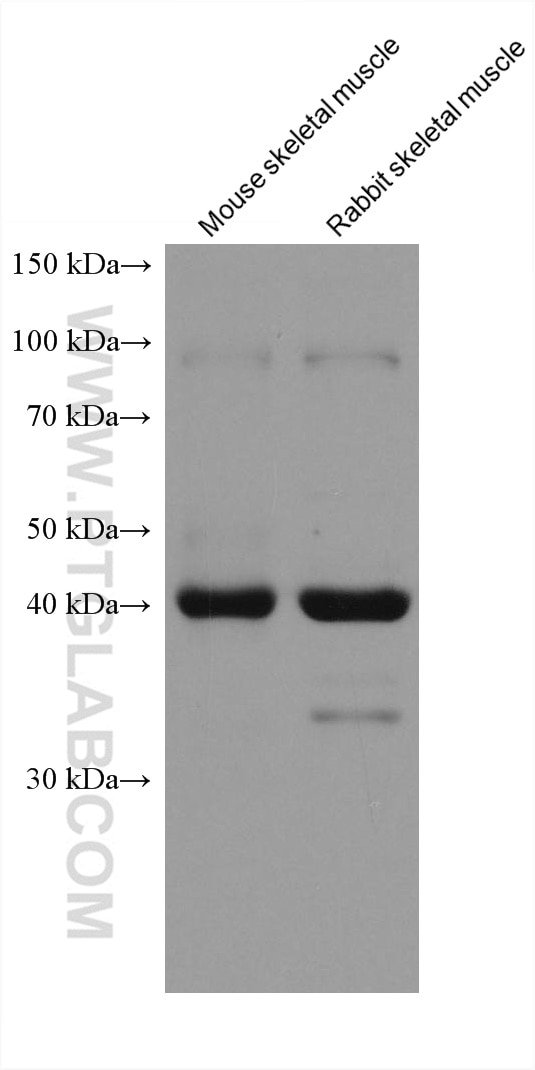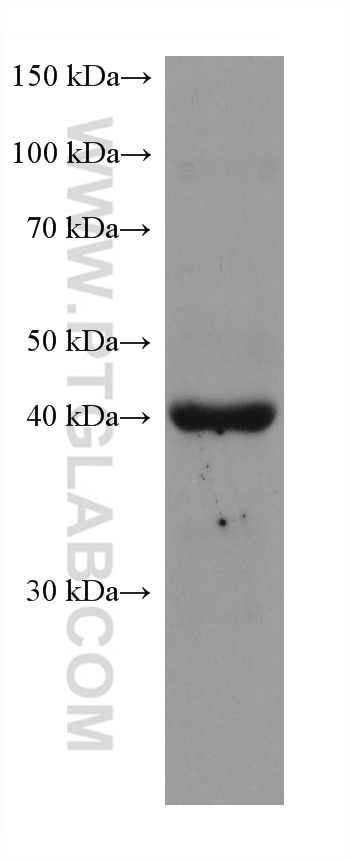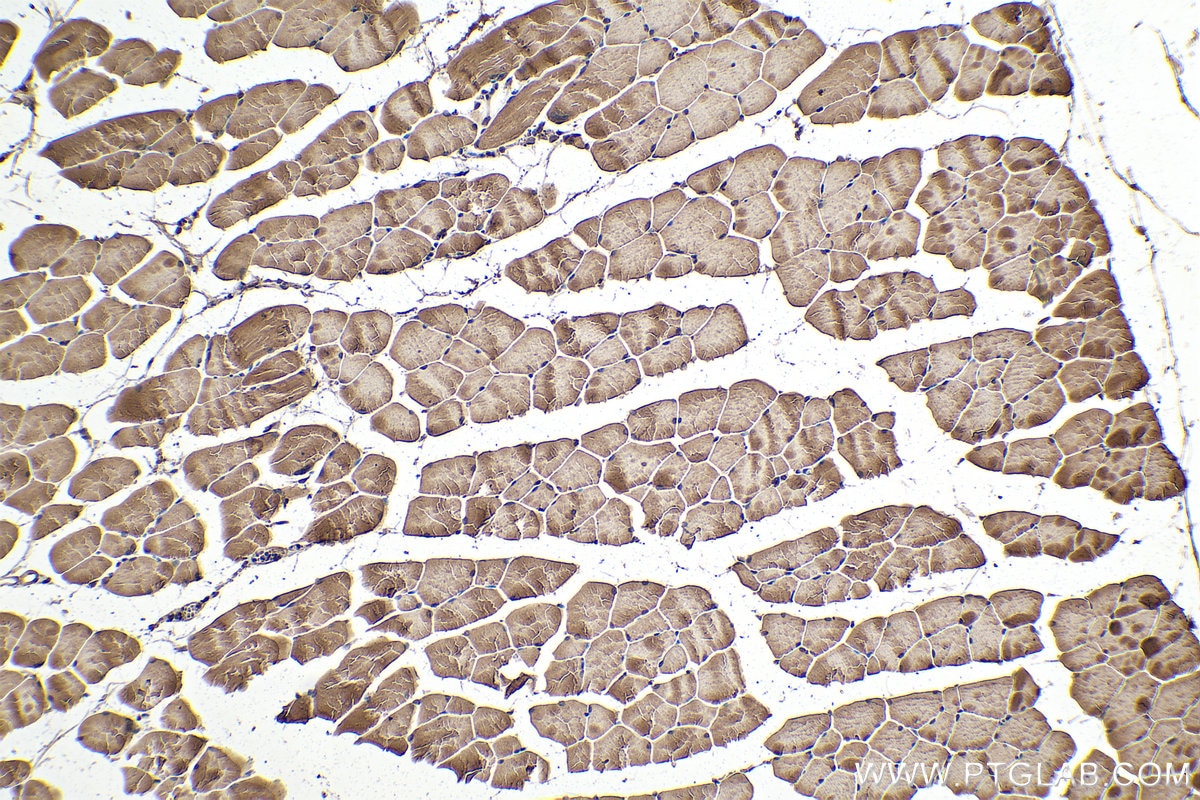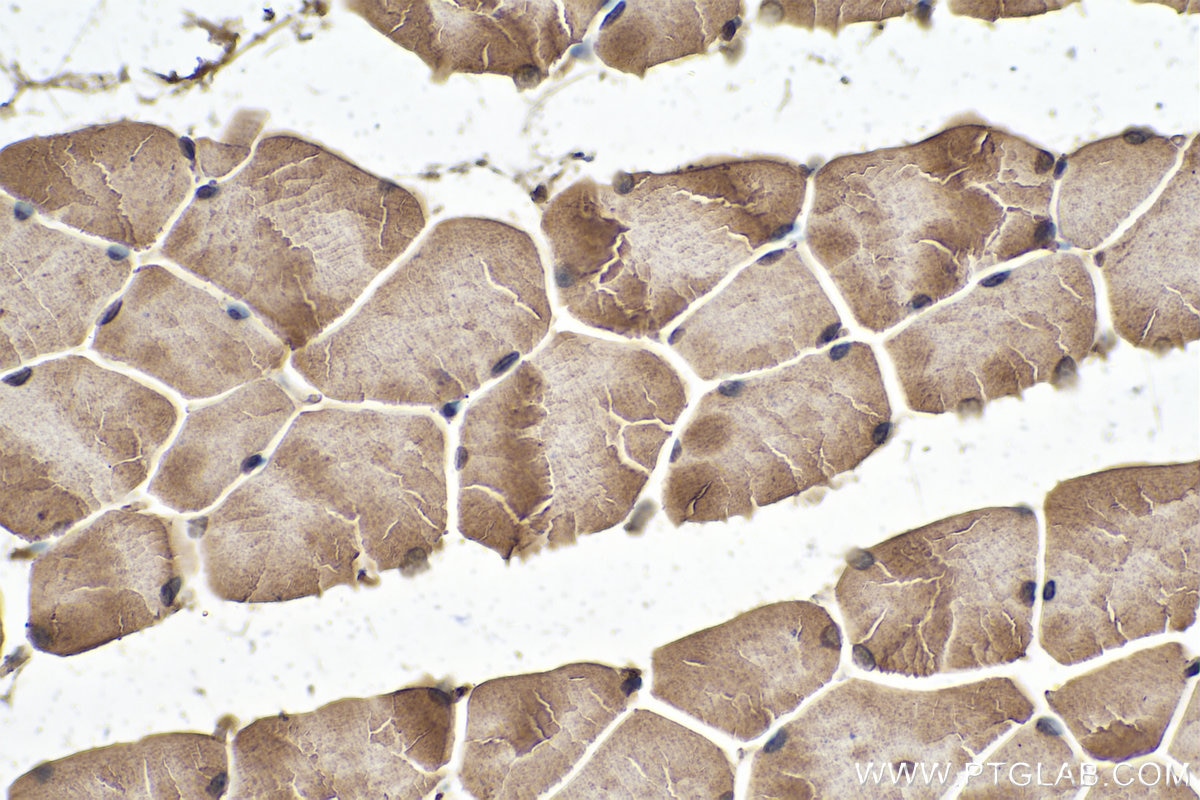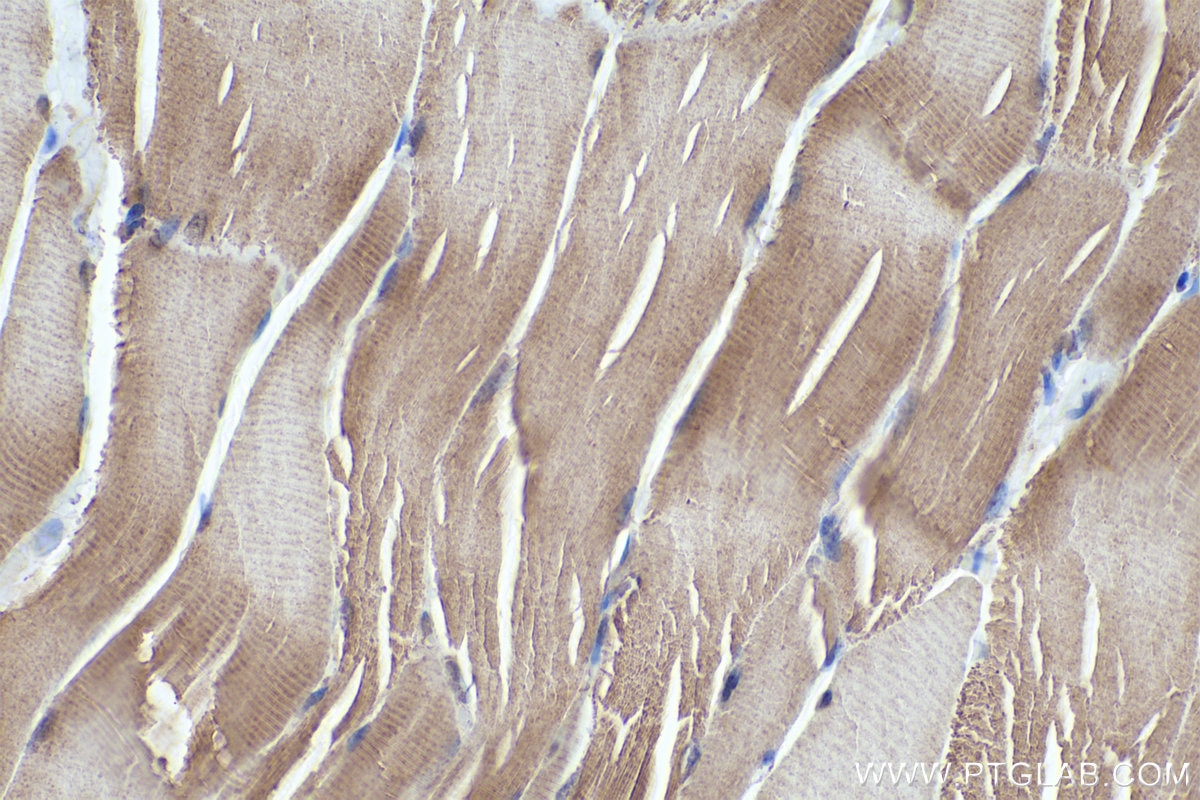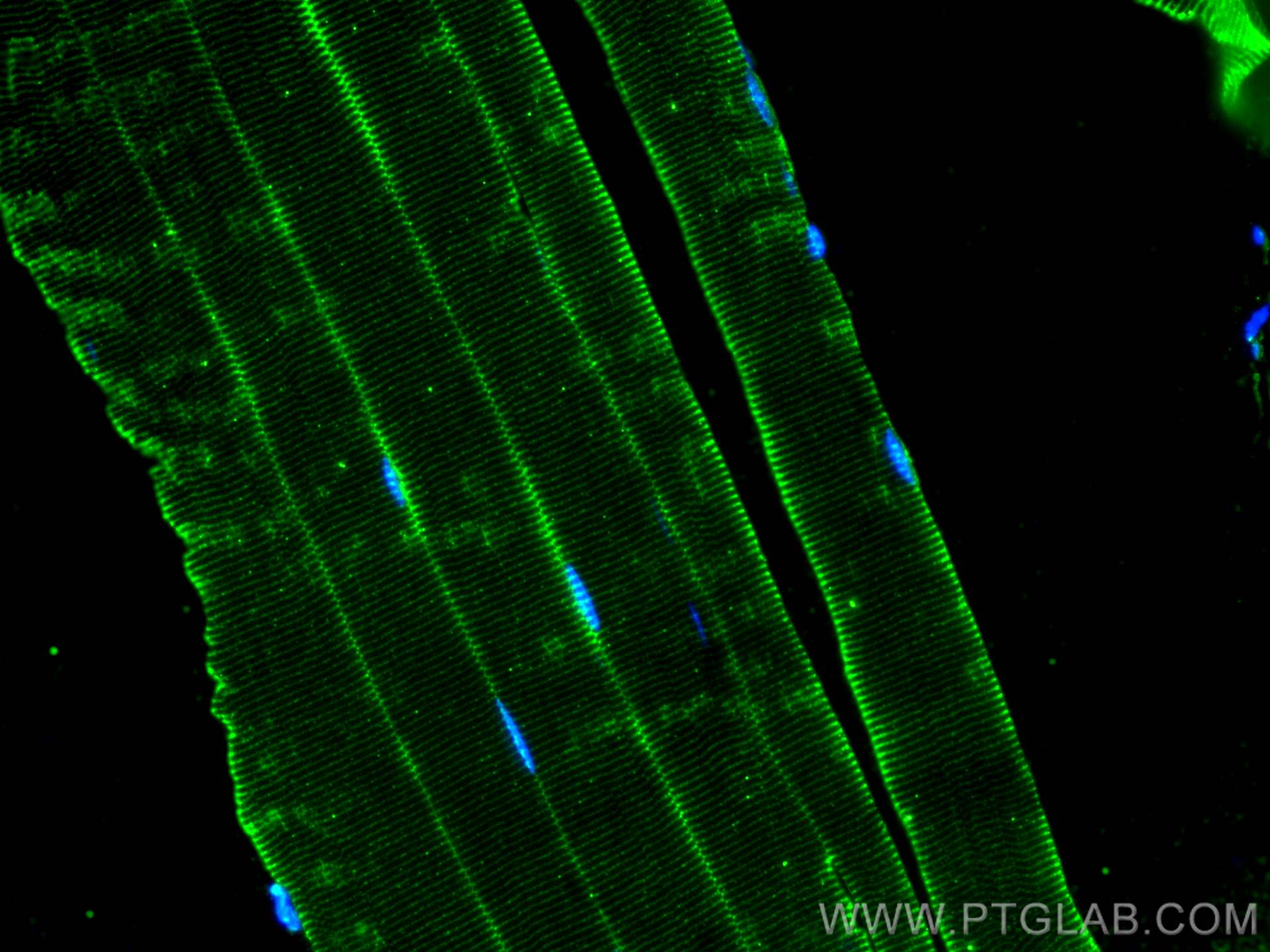Tested Applications
| Positive WB detected in | mouse skeletal muscle tissue, human heart tissue, pig heart tissue, pig skeletal muscle tissue, Rabbit skeletal muscle tissue |
| Positive IHC detected in | mouse skeletal muscle tissue, rat skeletal muscle tissue Note: suggested antigen retrieval with TE buffer pH 9.0; (*) Alternatively, antigen retrieval may be performed with citrate buffer pH 6.0 |
| Positive IF-P detected in | mouse skeletal muscle tissue |
Recommended dilution
| Application | Dilution |
|---|---|
| Western Blot (WB) | WB : 1:10000-1:50000 |
| Immunohistochemistry (IHC) | IHC : 1:2000-1:8000 |
| Immunofluorescence (IF)-P | IF-P : 1:50-1:500 |
| It is recommended that this reagent should be titrated in each testing system to obtain optimal results. | |
| Sample-dependent, Check data in validation data gallery. | |
Published Applications
| WB | See 39 publications below |
| IHC | See 17 publications below |
| IF | See 2 publications below |
| IP | See 1 publications below |
Product Information
67172-1-Ig targets FBXO32 in WB, IHC, IF-P, IP, ELISA applications and shows reactivity with human, mouse, rat, pig samples.
| Tested Reactivity | human, mouse, rat, pig |
| Cited Reactivity | human, mouse, rat, pig, canine |
| Host / Isotype | Mouse / IgG2b |
| Class | Monoclonal |
| Type | Antibody |
| Immunogen |
CatNo: Ag25247 Product name: Recombinant human FBXO32 protein Source: e coli.-derived, PET30a Tag: 6*His Domain: 1-216 aa of BC024030 Sequence: IAQKNFMNILEKVVLKVLEDQQNIRLIRELLQTLYTSLCTLVQRVGKSVLVGNINMWVYRMETILHWQQQLNNIQITRPAFKGLTFTDLPLCLQLNIMQRLSDGRDLVSLGQAAPDLHVLSEDRLLWKKLCQYHFSERQIRKRLILSDKGQLDWKKMYFKLVRCYPRKEQYGDTLQLRKHCHILSWKGTDHPCTANNPESCSVSLSPQDFINLFKF Predict reactive species |
| Full Name | F-box protein 32 |
| Calculated Molecular Weight | 355 aa, 42 kDa |
| Observed Molecular Weight | 42 kDa |
| GenBank Accession Number | BC024030 |
| Gene Symbol | FBXO32 |
| Gene ID (NCBI) | 114907 |
| RRID | AB_2882468 |
| Conjugate | Unconjugated |
| Form | Liquid |
| Purification Method | Protein A purification |
| UNIPROT ID | Q969P5 |
| Storage Buffer | PBS with 0.02% sodium azide and 50% glycerol, pH 7.3. |
| Storage Conditions | Store at -20°C. Stable for one year after shipment. Aliquoting is unnecessary for -20oC storage. 20ul sizes contain 0.1% BSA. |
Background Information
FBXO32 (F box only protein 32), also known as Atrogin 1 or MAFbx, is a member of the F-box protein family which is characterized by an approximately 40 amino acid motif F-box. This protein is an E3 ubiquitin ligase that is markedly up-regulated in muscle atrophy. FBXO32 is thus a potential drug target for the treatment of muscle atrophy. Some data support that FBXO32 may play an important role in tumorigenesis. Recent study reveal that FBXO32 targets the oncogenic protein c-Myc for ubiquitination and degradation through the proteasome pathway.
Protocols
| Product Specific Protocols | |
|---|---|
| IF protocol for FBXO32 antibody 67172-1-Ig | Download protocol |
| IHC protocol for FBXO32 antibody 67172-1-Ig | Download protocol |
| WB protocol for FBXO32 antibody 67172-1-Ig | Download protocol |
| Standard Protocols | |
|---|---|
| Click here to view our Standard Protocols |
Publications
| Species | Application | Title |
|---|---|---|
Nat Commun F-box protein FBXO32 ubiquitinates and stabilizes D-type cyclins to drive cancer progression | ||
Cell Death Dis FBXO32-mediated degradation of PTEN promotes lung adenocarcinoma progression | ||
Antioxidants (Basel) 5'-Cytimidine Monophosphate Ameliorates H2O2-Induced Muscular Atrophy in C2C12 Myotubes by Activating IRS-1/Akt/S6K Pathway | ||
Cell Biol Toxicol Statins induce skeletal muscle atrophy via GGPP depletion-dependent myostatin overexpression in skeletal muscle and brown adipose tissue. | ||
J Anim Sci Biotechnol Protective effects of taurine against muscle damage induced by diquat in 35 days weaned piglets. | ||
Life Sci N-acetylcysteine alleviates oxidative stress and apoptosis and prevents skeletal muscle atrophy in type 1 diabetes mellitus through the NRF2/HO-1 pathway |

